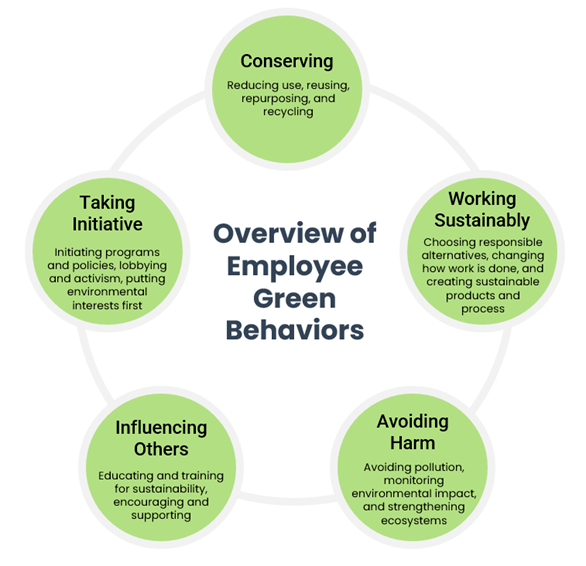Sustainability in the Workplace: Why it Matters and What You Can Do
March 11, 2022 in Culture, Culture & Workforce Wellness, Wonders of the Workplace, Workplace Sustainability
By Monica Shuler and Nathaniel Voss

The FMP Sustainability Committee is excited to kick off a 4-part series on the topic of workplace sustainability! Each quarter, a new blog will be posted that explores sustainability at work. In this first blog, we unpack what sustainability is and why it matters, and share specific steps employees can take to engage in sustainable behaviors in their jobs.
What is workplace sustainability?
To understand why workplace sustainability matters, it is first important to understand what workplace sustainability is. Broadly, sustainability means being able to meet one’s present needs without preventing future generations from meeting their needs.1 Within the workplace, sustainability formally means “measuring organizational success according to triple bottom line criteria [people, planet, profit], and acting individually and collectively to maximize effective use of natural resources and minimize negative impact on the planet.”2 When employees engage in sustainability-related actions at work, these are often referred to as green behaviors. These green behaviors may include (1) conserving, (2) working sustainably, (3) avoiding harm, (4) influencing others, and (5) taking initiative (see Figure 1).3

Why does sustainability matter?
Workplace sustainability can yield many positive consequences for both employees and organizations (often both at the same time!). The following section highlights some of these benefits.
Research shows that employees who engage in green behaviors at work also experience higher levels of engagement in their jobs.4 Given the well-known benefits of engagement (e.g., less burnout, higher job performance), this can mutually benefit people and organizations. Sustainability initiatives can also inspire employees to engage in innovative behaviors, which can be fulfilling and foster intrinsic motivation. Such initiatives can also benefit the parent organization. For example, it is estimated that 3M, which is viewed as a “green” company by the public, has saved millions of dollars in costs and prevented billions of pounds of pollution by implementing innovative, employee-driven sustainability projects.5 Additionally, when employees and organizations both value sustainability, employees can experience many positive workplace emotions that stem from this cultural fit (e.g., higher job satisfaction). Being able to express and act upon ones’ values (i.e., sustainability) at work can also enable people to find more meaning in their jobs, which can further enhance their workplace experiences. Sustainability can even benefit people’s health. For example, a recent study found that working in green-certified buildings can be connected to various physical health benefits (e.g., fewer sick days).6
In addition to these employee benefits, there are many organizational benefits to workplace sustainability. For example, having a commitment to sustainability can help companies better recruit employees.7 This is especially important in light of a recent survey about corporate social responsibility, which found that 83% of millennials would be more loyal to a company that values sustainability and addresses environmental issues.8 Sincerely valuing environmental sustainability can thus increase the prestige, reputation, and brand value of a company, which can help companies compete more effectively in the “war for talent”. As noted above, sustainability can also save organizations money and yield more efficient business operations. As another example, the projects that were carried out by the winners of Intel’s Environmental Excellence Awards in 2010 – which recognize innovative employee efforts to foster sustainability – yielded Intel an estimated cost savings of $126 million.9 In sum, while people and organizations will often engage in sustainable behaviors simply because it is the right thing to do, it is important to also recognize that there are many business benefits that can result from sustainability.
What You Can Do
Now that we have summarized some of the reasons why sustainability matters at work, we will provide some concrete strategies that employees can use to be sustainable within the workplace. Below are some tips for how you can help make your workplace more ecofriendly (click here to learn more)!

- Carry around a reusable bottle or thermos for your water or coffee instead of using plastic or Styrofoam cups, as these are not biodegradable.
- If you have to print on paper, use recycled paper and print double-sided. You can set your printer to automatically print double-sided and according to the EPA, printing double sided can reduce your paper waste by 10 – 40%.
- Decrease the brightness on your computer monitor or monitors. According to Harvard University’s energy manager, reducing your computer monitor’s brightness from 100% to 70% can save up to 20% of the monitor’s energy. Most people do not see a huge change from this adjustment, so be sure to try it!
- Did you know the average office worker generates about 2 pounds of paper waste every day? To offset this, try using a paperless notebook to take notes and decrease paper waste. Amazon has a variety of options to choose from. You can also store your notes on cloud-based services, like Google Drive and OneNote.
- And finally, always be on the lookout for more sustainable ways to do things. Do you really need a plastic bag for the items you’re grabbing at the local café for lunch? Try and take the stairs instead of the elevator a few days of the week – it’s not only good for you, but it’s good for the planet too!
There are many ways to take small steps towards a greener life – you don’t need to uproot your life to incorporate sustainable practices. And remember, any action that benefits the planet’s health makes a positive impact no matter how small and is worth taking.
References
- United Nations World Commission on Environment and Development (1987). Report of the World Commission on Environment and Development: Our Common Future.
- Klein, S. R., & Huffman, A. H. (2013). I-O psychology and environmental sustainability in organizations: A natural partnership. In A. H. Huffman, & S. R. Klein (Eds.), Green organizations: Driving change with I-O psychology (pp. 3-16). New York, NY: Routledge.
- Ones D. S. & Dilchert, S. (2012). Employee green behaviors. In S. E. Jackson, D. S. Ones, & S. Dilchert (Eds.), Managing HR for environmental sustainability. (pp. 85-116). San Francisco, CA: Jossey-Bass/Wiley.
- Ones, D. S. & Dilchert S. (2013). Measuring, understanding, and influencing employee green behavior. In A. H. Huffman, & S. R. Klein (Eds.), Green organizations: Driving change with I-O psychology (pp. 115-148). New York, NY: Routledge.
- DuBois, C. L. Z., Astakhova, M. N., % DuBois, D. A. (2013). Motivating behavior change to support organizational environmental sustainability goals. In A. H. Huffman, & S. R. Klein (Eds.), Green organizations: Driving change with I-O psychology (pp. 186-207). New York, NY: Routledge.
- MacNaughton, P., Satish, U., Guillermo, J., Laurent, C., Flanigan, S., Vallarino, J., Coull, B., … Allen, J. (2017). The impact of working in a green certified building on cognitive function and health. Building and Environment, 114, 178–186.
- Behrend, T. S., Baker, B. A., & Thompson, L. F. (2009). Effects of pro-environmental recruiting messages: The role of organizational reputation. Journal of Business and Psychology, 24, 341-350.
- Aziz, A. (2020). The power of purpose: The business case for purpose (All the data you were looking for pt 2). Forbes. Retrieved from https://www.forbes.com/sites/afdhelaziz/2020/03/07/the-power-of-purpose-the-business-case-for-purpose-all-the-data-you-were-looking-for-pt-2/?sh=579a2d3e3cf7
- Barrett C. R. & Niekerk, G. (2013). Sustainable business: A Fortune 500 corporate perspective. In A. H. Huffman, & S. R. Klein (Eds.), Green organizations: Driving change with I-O psychology (pp. 251-272). New York, NY: Routledge.

Monica Shuler joined FMP Consulting as the Project Controller in February of 2021. She has worked in the government contract field on the accounting side for over 10 years and has over 25 years’ experience in the accounting field. She is a “numbers girl” and all things pertaining to financials and problem solving. In her free time, Monica loves to spend time with her children and grandchildren and when she gets the chance quilting.

Nathaniel (Nate) Voss joined FMP Consulting as a Human Capital Consultant in May 2021. He received his Ph.D. in Industrial/Organizational Psychology from Kansas State University. Some of his favorite project topics and areas of expertise include competency modeling, data analytics, and survey methods. When he is not nerding out about one of these topics, Nate enjoys eating out at new restaurants and playing games with friends.